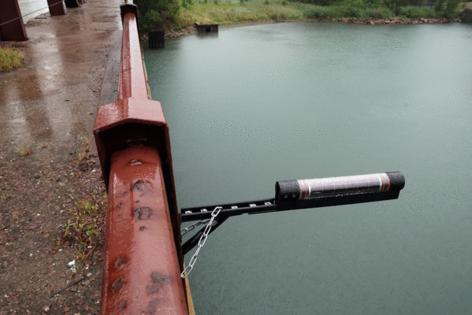New sensors are designed to predict flooding in Chicago
Published in News & Features
As the rain came down in sheets one summer afternoon late last month, Thomas Baranowski was sitting on the back porch of his Garfield Ridge home when his wife, Rose, stepped outside.
“‘Oh come on, you’ve got to see this,’” she told him.
He followed her down the steep stairwell to their basement, where water was spewing out of their flood drain “just like a geyser,” Baranowski, 79, recalled. Though he and Rose, 80, are lifelong Chicagoans and no strangers to urban flooding, they didn’t see the deluge coming — or the thousands of dollars in water damage that followed. But what if they had been given a heads-up the rain would hit their block so hard?
A new initiative recently launched in Chicago is striving to do just that.
Verizon, in conjunction with Chicago’s Center for Neighborhood Technology and a Michigan-based startup, is equipping the city with technology that will give officials and residents alike the ability to track urban flooding in real time. The venture, project partners say, could eventually help Chicago better respond to and mitigate the impact of flash floods — especially in areas that have historically faced the brunt of torrential rain — as human-made climate change intensifies storms in the Midwest and places pressure on the city’s outdated sewer system.
At the core of the initiative are wireless floodwater sensors that, using sonar technology, can calculate the depth of nearby water in seconds. The idea is to deploy a network of these sensors citywide, which together will be able to track when and where water levels are rising during a storm. To date, 10 sensors have been installed from South Deering on the Far South Side to Austin on the West Side, with 40 more due for installation over coming months.
This marks only the second time in the United States that technology of this kind has been deployed on a citywide scale.
The sensors are the product of Hyfi, an Ann Arbor company launched five years ago by University of Michigan engineering professor Branko Kerkez and his former doctoral student, Brandon Wong, after the pair sought to devise a technological solution to changing climate conditions, according to Wong, now CEO of the startup.
From California, Wong grew up around weather extremes, from droughts and flooding to wildfires, he said, noting he still remembers days when he’d wake up to “ash raining” from a bright orange sky. But it wasn’t until he moved out to Michigan for graduate school 12 years ago and shortly after saw historic flooding kill two people and cause millions of dollars of damage in Detroit that Wong knew he wanted to find a way to temper the impact of climate disasters.
Hyfi sensors can detect how high floodwaters are rising within a 30-foot radius by generating a continuous, nearly inaudible sound wave pulse on the water’s surface. To detect urban flooding, sensors are placed in low-lying areas, along viaducts and under manhole covers to see where water is pooling first or backing up, down to a city’s pipes. Data the sensors collect is reported to a central server, which Hyfi then visualizes in a map of real-time flood conditions.
The technology is making its Chicago debut as part of a larger effort by Verizon, using Hyfi’s sensor platform, to improve flood response and stormwater management systems across the country. The initiative first rolled out in New Orleans last summer and is due to launch in Detroit over the next year, according to Donna Epps, chief responsible business officer at Verizon.
For now, as sensors are piloted in Chicago, water level readings won’t be widely available quite yet, Wong said, but the goal is to have data live on a public-facing platform that residents can access. Wong pointed to New Orleans, where, after an initial citywide installation of 27 Hyfi sensors, the city integrated the data into its own public alert system.
The sensors could give communities and first responders a warning that flooding is imminent up to an hour before it hits, Wong says. That advance notice, Wong said, could be indispensable to local residents fearful of flood damage in their homes and for avoiding streets prone to flooding.
Almost every time it’s rained this year, Emmanuel Garcia has noticed that water pools on the streets and sidewalks around Belmont Cragin, where the 17-year-old has lived his entire life, he said. His family has had to stay in their apartment during storms for fear of encountering dangerous roadway conditions or having their basement flood, Garcia said.
Jean Flisk, 58, who grew up in Canaryville but now lives on the Southwest Side, said she “rain preps” her basement, which frequently floods during storms.
“If they say there’s a flood warning or the rain is going to be really bad, I have to go and move everything in the basement … just in case,” she said. “It’s aggravating, it’s a pain. I don’t know if there’s something to do.”
There is, Hyfi and Verizon hope. Beyond proactively reporting floods, the project’s partners imagine that over time, data can help inform long-term resilience planning, they say, particularly in areas of the city that have habitually been vulnerable to significant flooding.
Hyfi and Verizon are also collaborating with the Center for Neighborhood Technology, a Chicago-based urban research group, to host community meetings where residents can give their input on where and how they’d like to see sensors used. So far, the group has hosted meetings in Chatham and Belmont Cragin, two neighborhoods troubled with chronic flooding, with several more planned for this year. The meetings were held in tandem with local organizations, including the Greater Chatham Initiative on the South Side and the Grassroots Empowerment Mission and North River Commission on the Northwest Side.
With these meetings and the venture overall, the broader goal is to chart a path forward where “we systemically even stop the flooding from happening,” Center for Neighborhood Technology CEO Nina Idemudia said. “How do we work on improving the drainage system, improving where we make capital improvements in order to make sure the water is draining?”
Sensors won’t reveal new insights into which parts of Chicago are hit hardest by flooding, Idemudia said, but it could draw awareness to a long-standing need. She pointed to a 2019 study by the center that found urban flooding in Chicago disproportionately affects communities of color.
“Data is another way of accountability, right?” Idemudia said. “It’s one way to say you can’t deny our current circumstances or our lived experience anymore. Here’s the hard data. We’re going to hold you to making changes until the outlook and impact of this data changes.”
Following recent rainfall, the lived impact of urban flooding has been in full view. Since Wednesday, representatives from Chicago’s Office of Emergency Management and Communications, alongside the Federal Emergency Management Agency, Small Business Administration and the Illinois Emergency Management Agency and Office of Homeland Security, have been going door to door assessing homes for damage from storms and subsequent flooding that swept through the city last month.
These assessments follow disaster proclamations both Mayor Brandon Johnson and Cook County Board President Toni Preckwinkle issued on Aug. 6 to assist residents in recovering from the July storms. They will help determine if and how much government assistance residents will qualify for, according to OEMC Emergency Services Manager Kaila Lariviere.
Assessment teams have been directing their efforts based on a survey released a few weeks ago that gave residents the chance to self-report if they had been affected by the storms. Some 2,900 Cook County and Chicago residents reported damages, Lariviere said.
Last Thursday, assessment teams spent the morning walking through Garfield Ridge on the Southwest Side. One of the surveyed homes belonged to Larry Anguiano, a husband and father whose basement flooded entirely in last month’s storms, forcing his family to replace rugs, carpets and furniture in their home of the past five years, he told the Tribune.
“It was extremely quick,” he said, adding that since, he’s been wary of it happening all over again. “If there’s that type of rain and you see it fill up in the streets, (you think), ‘Oh no.’”
The Baranowskis, who were also visited by damage assessment teams last week, echoed the sentiment. The past few weeks have been “backbreaking” work to replace the walls and flooring of their flooded basement, Hope Baranowski said. The couple plans to install a flood control system because “we can’t have this happen again,” Thomas added.
When Chicago received from 1.5 to 4.5 inches of rainfall across the city last week, according to the National Weather Service, the Baranowskis waited anxiously for the storms to pass.
“I was scared to death,” Hope Baranowski recalled.
_____
©2025 Chicago Tribune. Visit chicagotribune.com. Distributed by Tribune Content Agency, LLC.







Comments